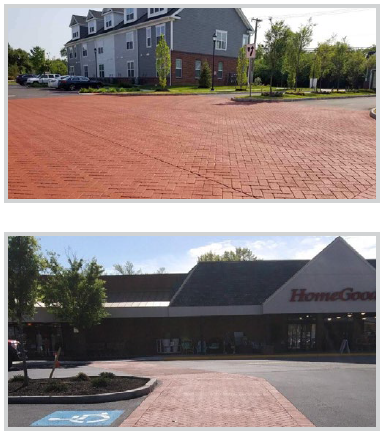 Stamped asphalt crosswalks and entrances can instantly enhance the appearance of your commercial or residential property. The stamping process is achieved by re-heating new or existing asphalt with an infrared process and using a steel cable template to imprint a pattern in the asphalt. A plate compactor is then used to press the pattern into the asphalt. After stamping, a polymer modified color coating is applied to the surface. A variety of patterns and colors are available. Commonly seen in South Jersey are both traditional brick and diagonal herringbone patterns, which are typically painted in a vibrant red color. This feature is a cost-effective way to increase the curb appeal of any property.
Stamped asphalt crosswalks and entrances can instantly enhance the appearance of your commercial or residential property. The stamping process is achieved by re-heating new or existing asphalt with an infrared process and using a steel cable template to imprint a pattern in the asphalt. A plate compactor is then used to press the pattern into the asphalt. After stamping, a polymer modified color coating is applied to the surface. A variety of patterns and colors are available. Commonly seen in South Jersey are both traditional brick and diagonal herringbone patterns, which are typically painted in a vibrant red color. This feature is a cost-effective way to increase the curb appeal of any property.
Download Printable Article (PDF) >>>
The Benefits of Stamped Asphalt Include:
• Aesthetics – Choose a pattern and color that complement your space. With numerous patterns and colors available, stamped asphalt crosswalks or entrances can provide an immediate upgrade to your property.
• Fast Installation – A crosswalk can typically be installed in just a few hours, which means minimum disruption to tenants, clients and residents. The area can be re-opened to traffic in a relatively short amount of time.
• Lower Installation Costs – Initial installation is less expensive than traditional brick or stone pavers. While traditional pavers are installed individually, the stamping process happens much more quickly, making it less labor-intensive.
• Lower Overall Maintenance Costs – stamped asphalt can last for years and is easily re-coated. The surface also resists changes in temperature better than pavers, which are prone to shifting during freeze-thaw cycles. There is also no need to remove vegetation that typically grows through the cracks of traditional brick.
• Safer Alternative – The paint adds a skid-resistant texture to the surface of the asphalt, so it is not slick when wet.
• Extend Asphalt Life – When exposed to the elements, asphalt dries out and cracks. The color coating applied after stamping protects the asphalt from harmful UV rays.



